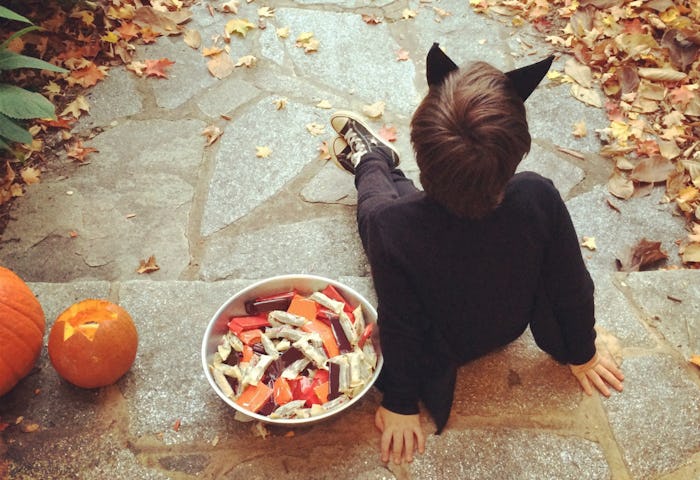Life

Should You Wipe Down Halloween Candy This Year? Experts Weigh In
Halloween is usually a pretty standard holiday, but thanks to 2020, families are now left wondering how they'll celebrate something that's usually so simple — costume, neighborhood, candy. But whether you plan to trick-or-treat as usual or opt to keep the kids in and watch spooky movies together, candy is sure to be involved. So regardless of how you get your treats this year, should you wipe down Halloween candy before you or your kids eat it? And how else can you ensure your children don’t pick up COVID-19 along with their lollipops and peanut butter cups?
The Centers for Disease Control and Prevention (CDC) recommend practicing social distancing and lots of hand-washing no matter how you celebrate on Halloween this year. But their Halloween guidelines don’t mention sanitizing any surfaces or candy wrappers. If you’re handing out candy this year, should you try to sanitize each piece before it goes in the trick-or-treat bowl?
“There’s been no evidence that food that comes prepared with pieces inside a wrapper is contaminated,” says Bethany Atkins, M.D., board-certified pediatrician with Baptist Pediatrics and Wolfson Children’s Hospital, in an interview with Romper. “The outside of the bag has probably been handled by people, but those little bars inside have probably never been touched by human hands. Even on the outside bag, there’s very low chance of transmission.”
“The thought of transmitting the virus this way is certainly possible, but it’s not the common way it gets done,” says Stan Spinner, M.D., VP and Chief Medical Officer at Texas Children’s Pediatrics and Texas Children’s Urgent Care, in an interview with Romper. “If you’re going to be placing wrapped candy out for people to come and pick up, it’s probably more the responsibility of people picking it up to wipe it down before opening it. Before it’s unwrapped and eaten, it should be wiped down.”
What about wiping it down a candy wrapper before you or your kiddo dive into the sweets inside? While it’s not totally necessary, Atkins says it can’t hurt, either.
“If it makes you feel safer, that’s fine! Whether they put the candy in individual bags and hand them out, or kids reach into the bucket themselves, someone may have touched it. More importantly, at every step, wash their hands before they eat their candy.”
“If you’ve purchased candy from the store I would wipe down the big bag, but the stuff inside the bag hasn’t been recently touched, so it should be fine when giving it to your own child,” adds Spinner. “If it has been touched by someone else, wipe it down. You want to minimize risk and that certainly will do so.”
But don’t feel like you have to Lysol every peanut butter cup wrapper before your kid opens it up (just do it if it makes you feel better). Gigi Youngblood, M.D., pediatrician at of Children's of Alabama, tells Romper in an interview that it’s more important to sanitize your child’s hands than their candy.
“As your kids eat their candy, make sure they are using excellent hand hygiene. You might want to bring along a few of their favorite treats from your own home candy stash to give them when they ask to dig into their Halloween loot while still out and about,” she says.
Atkins reassures parents that while the coronavirus can survive on smooth surfaces, chances are pretty low your child will pick it up from a candy wrapper.
“Back in March it was, ‘Oh my God, you can get it anywhere because it can live on hard surfaces for up to 19 days.’ More recent findings from August suggest that yes, it can live on hard surfaces, and our best educated guess is it can survive about a day under the right circumstances. But the risk can be almost eliminated if you just wash your hands for 20 seconds with warm water and soap.”
Lastly, it may be best to hand out candy outdoors where exposure to strangers is safer, per the CDC guidelines. It’s also important to keep your interactions brief.
“A significant exposure is 15 minutes spent within 6 feet of an unmasked person,” says Atkins. “Most trick-or-treaters are going door-to-door for a brief time — going up, taking candy, and walking away. Just be sure the person handing out candy is well.”
Youngblood explains that trick-or-treating is “inherently high-risk” this year and recommends alternative ways to celebrate, like a neighborhood costume parade or pumpkin carving outside. For those who choose to hand out candy, she has some tips.
“When preparing treats to give out, rather than sanitizing candy, I would recommend washing hands thoroughly and wearing a mask prior to opening the sealed package that individual candies come in,” she says. “Spreading out treats at the end of a driveway or edge of a yard is an effective way to prevent trick-or-treaters from clustering around a bowl or your doorway. Keep a mask on and continue to wash hands or use hand sanitizer as you replenish the treats. If we don't want post-Halloween massive community outbreaks, we have to mask.”
Sources:
Bethany Atkins, M.D., board-certified pediatrician with Baptist Pediatrics and Wolfson Children’s Hospital
Stan Spinner, M.D., VP and Chief Medical Officer at Texas Children’s Pediatrics and Texas Children’s Urgent Care
Gigi Youngblood, M.D., pediatrician at of Children's of Alabama
This article was originally published on